Slate fence is a popular solution. The material is affordable, lightweight, easy to install. Now there are other options that satisfy the same requirements, but the availability of slate still decides this issue in its favor.
General information about the slate fence
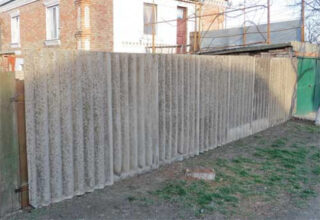
Slate is a well-known roofing material. Made from asbestos, cement and water. Asbestos fibers are distributed in the mass of the mixture and create a kind of frame, the cells of which are filled with cement. Such material is not durable. Nevertheless, they take it not only for the roof, but also for the construction of a variety of buildings, sheds, enclosing structures.
Slate is used in cases where the fence needs to be erected as quickly as possible, and the aesthetic side of the issue is of little concern to the owners of the site. This is often a temporary solution.
There are 2 controversial points that arise during the construction of a slate fence:
- Fragility - the fabric of the sections is solid, which means it is exposed to a high wind load. The mechanical strength of the material is poor. It is best used for internal partitions or fences between adjacent areas.
- Deaf sections. Such an intake makes it difficult for air to circulate. In many regions, the construction of a solid fence is prohibited and such a fence can be erected only after obtaining the appropriate permit.
If slate sections are combined with chain-link sections, the fence turns out to be just as cheap, but does not interfere with air circulation.
Advantages and disadvantages of the design
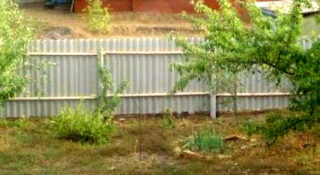
Slate fence has a lot of advantages:
- Cheapness. Material of any class and type can be purchased at any time and in lots of any size.
- The canvas is light enough that the simplest small diameter metal piles can be used for the support posts.
- The slate can be easily attached to brick and metal posts.
- Installation of the fence takes a minimum of time.
- The material does not burn, is not sensitive to chemically aggressive substances.
- The sheets do not have high sound insulation. Nevertheless, in case of heavy rain or hail, they emit much less noise than a construction from a professional sheet.
- Slate is resistant to temperature fluctuations, not afraid of water and snow, although it loses its appearance over time.
- The fence is easy to repair, it is enough to replace the damaged section.

There are a lot of cons:
- The material is not very strong and, moreover, fragile. A successful hit with a stone is enough to damage the section.
- Resistance to moisture is not so great, so it is better not to use slate in areas with frequent rains.
- Due to the large windage of the deaf section, over time, it shifts, tilts.
- Slate is unattractive. Fences are usually painted or decorated in other ways.
Asbestos is part of the slate. This makes the material hazardous when cutting and drilling. Such work is carried out in a protective mask. Storage of material, transportation and fastening to the frame is not dangerous.
Slate varieties
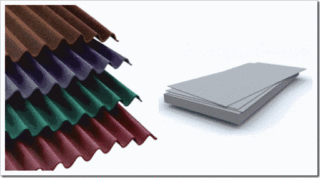
The characteristics of the material fully meet the requirements for roofing:
- Slate sheets can withstand a point load of up to 70 kg.They are not covered with cracks, do not deform, losing their shape.
- Durability according to GOST is 30 years, provided that the material is used for its intended purpose.
- By dyeing, you can increase the resistance of the slate to the action of water. Painted sheets last 1.5 times longer than unpainted ones.
- Leaf weight reaches 18.5 kg. Such a canvas is quite easy to lay on an inclined crate, but it is not so easy to install it vertically.
Slate is produced in 2 main types - flat and wave. The first sheet has a flat surface. The wave has a specific profile shape. This feature provides a higher strength and rigidity of the material, as well as good resistance to wind loads.
When installing a fence, the presence or absence of relief does not really matter, however, a fence made of flat slate in the country house looks more aesthetically pleasing.
For fences, you need to choose the material that is as strong as possible, with a higher density. A sheet installed vertically is subject to much more stress than in a horizontal or inclined position. Most often, wave slate of the UV brand is recommended for fences - a unified profile, with an average wave size. It differs from its counterparts in higher density.
The weight of such a sheet reaches 26 kg. The width is large, so a minimum number of sheets is required to install even a long fence.
If the fence is made of flat slate, it is advised to buy a pressed one. It weighs 10% more than unpressed, but its strength is 25% more than usual. The compacted material tolerates frost better: withstands more than 50 complete freeze cycles.
Calculation of the required amount of material

The calculation for the fence is very simple. Determine the length of the fence and divide the resulting value by the dimensions of a regular sheet.
Standard dimensions: 2.5 x 1.2 meters with a thickness of 6, 8 and 10 mm. It makes no sense to take into account the size of the pillars, it is easier to cut the sheets to size.
When buying material, you need to pay attention to the accuracy of the linear dimensions. An error of 5 mm is allowed.
Height is a difficult moment. The sheet parameters are standard, but the requirements for the height of the railing are different. To protect the site, it is proposed to build a fence with a height of 2 m. But since a fence made of flat or wave slate is a wind and airtight structure, its height is reduced to 75 cm. Additional restrictions apply in different areas.
What you need to work
To build a fence, you need the following materials and tools:
- slate - wave or flat;
- bars with a cross section of 50 * 130 mm or metal shaped pipes;
- fasteners - steel corners, profile sections, bolts, screws, nails;
- roofing material for waterproofing;
- crushed stone, cement, sand and water for the preparation of concrete;
- concrete mixer;
- welding machine, grinder, drill;
- hacksaw, wrench, other auxiliary tools.
At the preparatory stages, you will also need a shovel, a hand drill, and a plumb line.
Self-construction of a slate fence
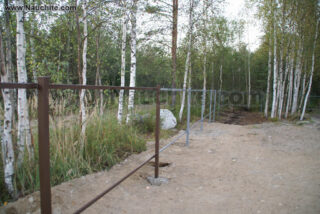
A do-it-yourself fence made of flat slate is constructed using the following detailed diagram.
- Mark the site: pegs are driven in at the corners, the cord is pulled, and then along this line the places for the intermediate racks are marked.
- They dig holes in the ground along the lighthouses. It is easier and faster to drill a hole. A depth of 60–80 cm is recommended. The indentations should be the same.
- Steel supports are cleaned of rust, treated with hot bitumen, anti-corrosion liquid.
- The hole is lined with roofing material, a support is installed in it and given a vertical position with the help of props. Then the hole is poured with concrete. The spacers can be removed after a week when the concrete has set.
- Metal strips or plates are welded to the posts for attaching slate. The structure is again treated with an anti-corrosion compound in 2 layers.
- A shallow trench is dug between the posts, into which a brick base is laid. This operation is optional, but such a fence will be stronger.
- Holes for fasteners are drilled in wooden slats and the slats are fixed on the mounting strips.
- The slate sheet is installed vertically, the holes for fasteners are marked and drilled in the canvas.
- The sheets are screwed to the wooden slats with self-tapping screws. Pieces of rubber or wide washers are placed under the caps of the screws. Be sure to check the verticality of the section with a plumb line.
- To turn a blind fence into a ventilated one, the slate is fixed by lifting the sheet 10 cm from the ground. Another option is to make ventilation gaps between the posts and sections of the fence.
The finished fence made of flat or corrugated slate is painted. Often a section turns into a canvas for an artist. The fence depicts landscapes, scenes from cartoons.
Fence maintenance
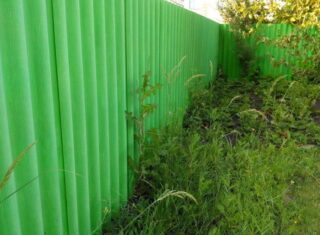
Slate is not a demanding material. Fence maintenance is minimal:
- Periodically it is necessary to check the vertical position of the sections. Under the influence of strong winds, and sometimes under its own weight, the canvas tilts, which leads to deformations.
- For staining, use special acrylic paints for slate. Such formulations create a waterproof film.
- Paint layers should be renewed periodically.
Slate fence is a cheap and affordable option. Pros: speed of construction and ease of maintenance. Cons: Poor damage resistance, unpresentable, and airtight.








